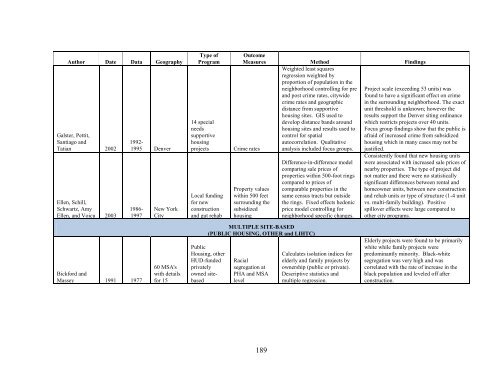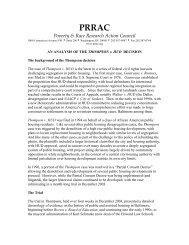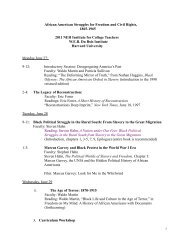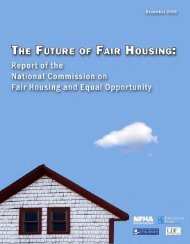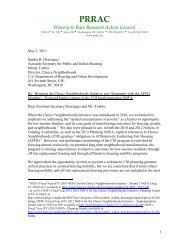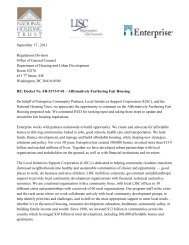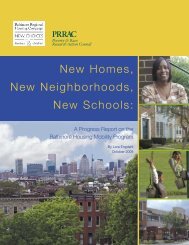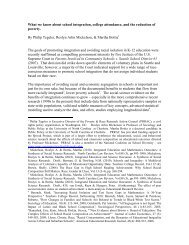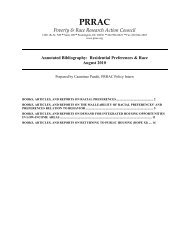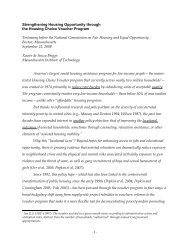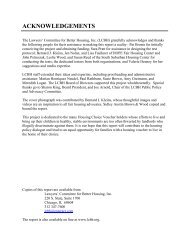The Spatial Concentration of Subsidized Housing - Poverty & Race ...
The Spatial Concentration of Subsidized Housing - Poverty & Race ...
The Spatial Concentration of Subsidized Housing - Poverty & Race ...
You also want an ePaper? Increase the reach of your titles
YUMPU automatically turns print PDFs into web optimized ePapers that Google loves.
Author Date Data GeographyGalster, Pettit,Santiago andTatian 2002Ellen, Schill,Schwartz, AmyEllen, and Voicu 20031992-1995 Denver1986-1997New YorkCityType <strong>of</strong>Program14 specialneedssupportivehousingprojectsLocal fundingfor newconstructionand gut rehabOutcomeMeasures Method FindingsWeighted least squaresregression weighted byproportion <strong>of</strong> population in theneighborhood controlling for preand post crime rates, citywidecrime rates and geographicdistance from supportivehousing sites. GIS used todevelop distance bands aroundhousing sites and results used tocontrol for spatialautocorrelation. Qualitativeanalysis included focus groups. justified.Crime ratesProperty valueswithin 500 feetsurrounding thesubsidizedhousingDifference-in-difference modelcomparing sale prices <strong>of</strong>properties within 500-foot ringscompared to prices <strong>of</strong>comparable properties in thesame census tracts but outsidethe rings. Fixed effects hedonicprice model controlling forneighborhood specific changes.Project scale (exceeding 53 units) wasfound to have a significant effect on crimein the surrounding neighborhood. <strong>The</strong> exactunit threshold is unknown; however theresults support the Denver siting ordinancewhich restricts projects over 40 units.Focus group findings show that the public isafraid <strong>of</strong> increased crime from subsidizedhousing which in many cases may not beConsistently found that new housing unitswere associated with increased sale prices <strong>of</strong>nearby properties. <strong>The</strong> type <strong>of</strong> project didnot matter and there were no statisticallysignificant differences between rental andhomeowner units, between new constructionand rehab units or type <strong>of</strong> structure (1-4 unitvs. multi-family building). Positivespillover effects were large compared toother city programs.Bickford andMassey 1991 197760 MSA'swith detailsfor 15MULTIPLE SITE-BASED(PUBLIC HOUSING, OTHER and LIHTC)Public<strong>Housing</strong>, otherHUD-fundedprivatelyowned sitebasedRacialsegregation atPHA and MSAlevelCalculates isolation indices forelderly and family projects byownership (public or private).Descriptive statistics andmultiple regression.Elderly projects were found to be primarilywhite while family projects werepredominantly minority. Black-whitesegregation was very high and wascorrelated with the rate <strong>of</strong> increase in theblack population and leveled <strong>of</strong>f afterconstruction.189


